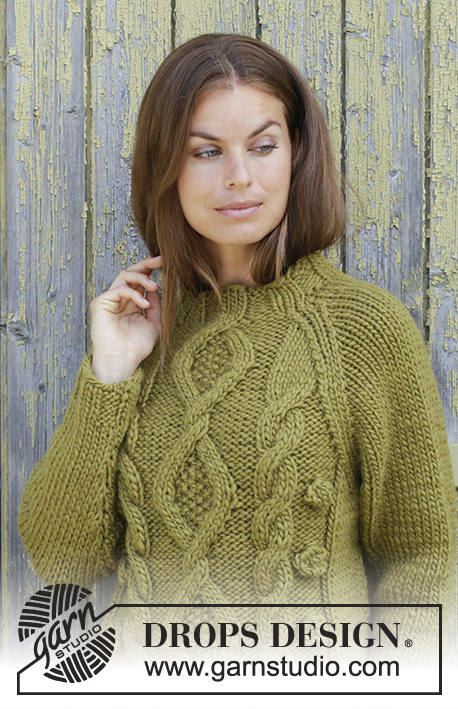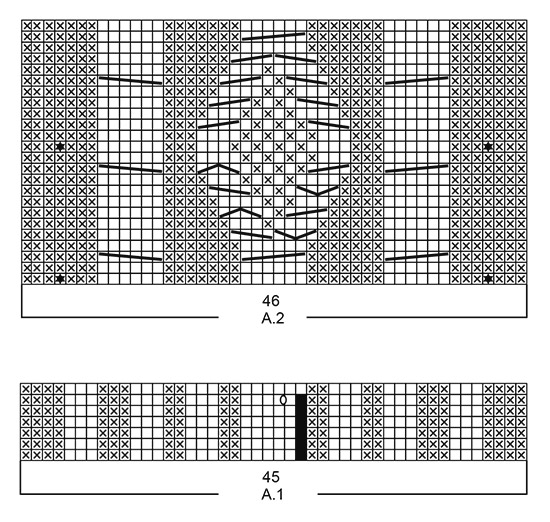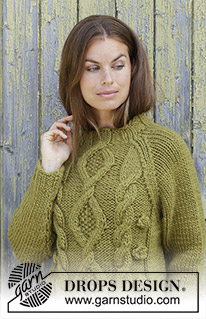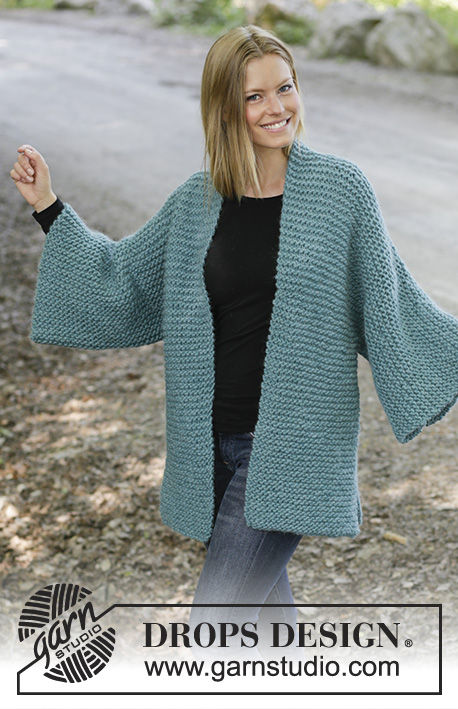Green Tea |
||||||||||||||||||||||||||||||||||
 |
 |
|||||||||||||||||||||||||||||||||
Knitted jumper with raglan in DROPS Snow. Piece is knitted bottom up with cables and bobbles. Size: S - XXXL
DROPS 196-32 |
||||||||||||||||||||||||||||||||||
|
EXPLANATION FOR THE PATTERN: ---------------------------------------------------------- PATTERN: See diagrams A.1 and A.2. DECREASE/INCREASE TIP (evenly): To calculate how to decrease/increase evenly, use the number of stitches decreases are done over (e.g. 45 stitches) and divide by number of decreases to be done (e.g. 9) = 5. In this example knit approx. every 4th and 5th stitch together. When increasing evenly make 1 yarn over (in this example) after every 5th stitch. On next round knit yarn over twisted to avoid holes. DECREASE TIP-1 (applies to sides of body): Decrease 1 stitch on each side of marker thread as follows: Work until 3 stitches remain before marker thread and knit 2 together, knit 2 (marker thread is between these stitches), slip 1 stitch knitwise, knit 1, pass slipped stitch over stitch worked. DECREASE TIP-2 (applies to last round before neck edge): To make the decrease look nice before neck edge decrease by knitting 2 stitches together when knitting and decrease by purling 2 stitches together when purling. INCREASE TIP (applies to sides on body and under sleeves): Work until 2 stitches remain before marker thread, 1 yarn over, knit 4 (marker thread is in the middle of these stitches), 1 yarn over. On next round knit yarn over twisted to avoid holes. Then work the new stitches in stocking stitch. RAGLAN: Decrease first 1 stitch on each side of marker threads (= 8 stitches decreased on round) as follows: Decrease 1 stitch after marker thread on front/back piece as follows: Knit 1, slip 1 stitch knitwise, knit 1, pass slipped stitch over stitch worked (= 1 stitch decreased) Decrease 1 stitch before marker thread on front/back piece as follows: Work until 3 stitches remain before marker thread, knit 2 together (= 1 stitch decreased), knit 1. Decrease 1 stitch after marker thread on sleeve as follows: Slip 1 stitch knitwise, knit 1, pass slipped stitch over stitch worked (= 1 stitch decreased). Decrease 1 stitch before marker thread on sleeve as follows: Work until 2 stitches remain before marker thread, knit 2 together (= 1 stitch decreased). When decrease has been done 10-12-13-14-17-19 times, continue decrease as before on sleeves and on back piece but now decrease 2 stitches in each side of front piece (= 10 stitches decreased on round) as follows: Decrease 2 stitches after marker thread on front piece as follows: Knit 1, slip 1 stitch knitwise, knit 2 together, pass slipped stitch over stitches worked (= 2 stitches decreased). Decrease 2 stitches before marker thread on front piece as follows: Work until 4 stitches remain before marker thread, knit 3 together (= 2 stitches decreased), knit 1. ---------------------------------------------------------- START THE PIECE HERE: ---------------------------------------------------------- JUMPER - SHORT OVERVIEW OF THE PIECE: Work piece in the round on circular needle, bottom up. Work sleeves in the round on double pointed needles/a short circular needle. BODY: Cast on 132-144-150-162-174-186 stitches on circular needle size 8 mm with Snow. Knit 1 round. Now work rib as follows: Work (knit 3/purl 3) over the first 45-51-57-63-69-75 stitches, work A.1 (= 45 stitches), work (knit 3/purl 3) over the remaining 42-48-48-54-60-66 stitches. Continue in the round like this until 1 round remains in A.1. Work next round as follows: Knit the first 45-51-57-63-69-75 stitches and decrease 9-11-12-13-14-14 stitches evenly over these stitches – read DECREASE/INCREASE TIP, work last round in A.1, knit the remaining 42-48-48-54-60-66 stitches and decrease 7-9-6-9-8-8 stitches evenly over these stitches = 117-125-133-141-153-165 stitches. Switch to circular needle size 9 mm. Now work A.2 (= 46 stitches) over A.1 and work in stocking stitch over the remaining stitches on round. REMEMBER THE KNITTING TENSION! When piece measures 9 cm, insert 1 marker thread 9-11-13-15-18-21 stitches before A.2 and 9-11-13-15-18-21 stitches after A.2 (= in each side). There are now 64-68-72-76-82-88 stitches on front piece and 53-57-61-65-71-77 stitches on back piece. Move the marker threads upwards when working. On next round decrease 1 stitch on each side of marker thread in each side – read DECREASE TIP-1. Decrease like this every 4th-4th-4th-5th-5th-5th round 3-3-3-2-2-2 times in total = 105-113-121-133-145-157 stitches. When piece measures 21 cm, increase 1 stitch on each side of marker threads in each side - read INCREASE TIP = 109-117-125-137-149-161 stitches. Continue until piece measures approx. 27 cm in all sizes. On next round cast off 3 stitches on each side of marker thread in each side for armhole (= 6 stitches under each sleeve). There are now 54-58-62-68-74-80 stitches on front piece and 43-47-51-57-63-69 stitches on back piece. Put piece aside and work the sleeves. SLEEVE: Cast on 24-24-24-30-30-30 stitches on double pointed needles size 8 mm with Snow. Knit 1 round. Then work rib (= knit 3/purl 3) for 5 cm. Knit 1 round while decreasing 2-2-0-2-2-0 stitches evenly = 22-22-24-28-28-30 stitches. Insert a marker thread at beginning of round (= mid under sleeve). Switch to double pointed needles size 9 mm. Work in stocking stitch in the round. When piece measures 8-10-9-10-10-7 cm, increase 1 stitch on each side of marker thread under sleeves - remember INCREASE TIP. Increase like this every 8th-5th-5th-5th-3rd-3rd round 6-8-8-7-10-11 times in total = 34-38-40-42-48-52 stitches. When piece measures 37-35-34-32-30-29 cm, increase 1 stitch on each side of marker thread every other round 4 times in total = 42-46-48-50-56-60 stitches. On next round cast off 6 stitches mid under sleeve (= 3 stitches on each side of marker thread) = 36-40-42-44-50-54 stitches. Sleeve measures 43-41-40-38-36-35 cm. Put piece aside and knit the other sleeve. YOKE: Slip sleeves on to same circular needle as body where armholes were cast off = 169-185-197-213-237-257 stitches. Insert a marker thread in all transitions between sleeves and body (= 4 marker threads in piece). Begin round in transition between left sleeve and back piece. Continue with pattern on front piece as before and work in stocking stitch over the remaining stitches on round. When 4-2-2-4-2-1 round has been worked, begin decrease for RAGLAN – read explanation above. Decrease like this every other round 10-12-13-14-17-19 times in total = 89-89-93-101-101-105 stitches. Then continue decrease for raglan as before on sleeves and back piece and now decrease 2 stitches in each side for raglan on front piece. Decrease like this every other round 4 times in total = 49-49-53-61-61-65 stitches. When there is not enough stitches to work cables in A.2 on front piece, continue with knit over knit and purl over purl over these stitches. When all decreases for raglan are done, work next round as follows: Knit over stitches on back piece and decrease 1-0-1-3-2-3 stitches evenly over these stitches, knit over the 8 stitches on sleeve, knit over knit and purl over purl over stitches on front piece and decrease 4-3-4-6-5-6 stitches evenly over these stitches – read DECREASE TIP-2 and remember DECREASE/INCREASE TIP, knit over the 8 stitches on sleeve = 44-46-48-52-54-56 stitches. Jumper measures approx. 54-56-58-60-62-64 cm from neck mid front and down. NECK EDGE: Switch to a short circular needle size 8 mm. Knit 1 round while increasing 4-2-6-2-6-4 stitches evenly - remember DECREASE/INCREASE TIP = 48-48-54-54-60-60 stitches. Work rib (knit 3/purl 3) for 5 cm. Cast off stitches with knit over knit and purl over purl. |
||||||||||||||||||||||||||||||||||
Diagram explanations |
||||||||||||||||||||||||||||||||||
|
||||||||||||||||||||||||||||||||||

|
||||||||||||||||||||||||||||||||||

|
||||||||||||||||||||||||||||||||||
|
Have you made this or any other of our designs? Tag your pictures in social media with #dropsdesign so we can see them! Do you need help with this pattern?You'll find tutorial videos, a Comments/Questions area and more by visiting the pattern on garnstudio.com. © 1982-2024 DROPS Design A/S. We reserve all rights. This document, including all its sub-sections, has copyrights. Read more about what you can do with our patterns at the bottom of each pattern on our site. |
||||||||||||||||||||||||||||||||||










































































Comments / Questions (30)
Jag stickar tröjan Green Tea och funderar på längden på ärmen, är det så att storlek S har längst ärm, 43 cm. Tycker att det inte kan stämma. Kan måtten vara omkastade?
15.11.2022 - 16:49DROPS Design answered:
7) Varför är ärmarna kortare i större storlekar? I de större storlekarna kommer den totala vidden (från handled till handled) att vara större än i de mindre storlekarna, även om själva ärmen är kortare. De större storlekarna har längre ärmkupa samt bredare axelvidd. Detta resulterar i en bra passform i alla storlekar.
16.11.2022 - 12:17Hej! Jag skulle gärna vilja sticka denna med vanliga stickor och inte rundstickor. Går det att få mönstret översatt till ett gammeldags traditionellt mönster ?
01.09.2021 - 22:01DROPS Design answered:
Hej Ann-Charlott, vi kan ikke skrive opskriften om, men du finder flere videoer om hvordan man følger den her opskrift. Så prøv :)
02.09.2021 - 15:57Ohjeen kohdasta Etu-ja takakappale on kysyttävää: Kun piirroksen A.1 mallineuletta on jäljellä 1 kerros, seuraavan kerroksen kavennusohje on hämmentävä. Mitä tarkoittaa \"kavenna tasavälein näiden silmukoiden kohdalla 9-11-12-13-14-14 silmukkaa\" ja \"kavenna tasavälein näiden silmukoiden kohdalla 7-9-6-9-8-8 silmukkaa\" lopputuloksena pitäisi olla 117-125-133-141-153-165 silmukkaa. Kuuluuko puseron puolista tulla keskenään epäsymmetriset?
08.11.2020 - 10:07Hej, jeg vil gerne strikke denne model, men i air og brushed alpaca, hvordan omregner jeg, hvor meget jeg skal bruge af hver? desuden vil jeg gerne kombinere modellen med mønstret cozy weekend sweateren (altså den store snoning midt for samt halsen fra denne, kan jeg ikke bare gøre det, uden at det ødelægger opskriften (altså antal masker og mål)?
13.10.2020 - 23:29DROPS Design answered:
Hei Susanne. Du kan fint bytte ut DROPS Eskimo med DROPS Air + DROPS Brushed AlpacaSilk, bare sjekk at du får den strikkefastheten som er oppgitt i oppskriften. Du kan regne ut garnmengden ved å bruke vår garnkalkulator, den finner du under hver oppskrift (grønn link). Design avd. har dessverre ikke muligheten til å regne ut mål og masker ved å forandre fletten. mvh DROPS design
19.10.2020 - 10:50Au début pour le dos/devant, après avoir fait une première fois A1, vous dites "Continuer en rond ainsi jusqu'à ce qu’il reste 1 tour de A.1 à faire" ?? Combien de fois doit-on faire A1 avant de faire A2 ? Merci beaucoup pour votre aide
08.05.2020 - 17:25DROPS Design answered:
Bonjour Martina, vous tricotez ainsi tous les rangs de A.1 autrement dit 7 rangs au total (en augmentant au 6ème tour dans A.1 et au 7ème tour = en augmentant comme indiqué dans les autres mailles en côtes). Vous tricotez ensuite les 46 mailles de A.2 au-dessus des 46 mailles de A.1. Bon tricot!
11.05.2020 - 08:13J'ai monté 150m, Pour les premiers rangs après les côtes 3/3, vous dites de supprimer 12m, tricoter A1 soit 45m, puis diminuer 6m = 132m et non 133m comme vous l'indiquez ?
08.05.2020 - 10:30DROPS Design answered:
Bonjour Martina, à l'avant-dernier rang de A.1, on augmente 1 maille (cf jeté au milieu du diagramme environ), on va donc avoir 46 m dans A.1 et 133 m au total. Bon tricot!
08.05.2020 - 11:03Worried about length to arm only 27cm, too short? I am quite petite. how many repeat diamond cables should i do before arm cast off? I want it to look like the picture. Thank you!
26.02.2020 - 15:49DROPS Design answered:
Dear Emily, thi is a rather short sweater, but if you are worried about the length, please take a sweater that is comfortable, and compare its measuremnst to the numbers given on the schematic drawings at the bottom of the patternm and adjust the number of rows accordingly. Happy Knitting!
27.02.2020 - 05:07Jeg er gået igang med at strikke denne opskrift og der er altså fejl i opskriften. I målskemaet er målet nederst (str. M) = 57 cm (=114 cm hele vejen rundt). Strikkefastheden er 10 cm for 10 masker og den overholder jeg. Når jeg så slår 144 masker op (som anvist i opskriften for str. M) ender jeg jo med en bredde på 144 cm. Jeg kan godt selv "blot" ændre antallet, så jeg slår 114 masker op - men hvordan påvirkes ind- og udtagninger samt raglan-anvisninger af ændringen i antal?
07.02.2020 - 11:43DROPS Design answered:
Hej Mette, Vi slår flere masker op for at ribben i kanten ikke skal blive for stram, der tages masker ind inden du starter på A.2 og hver snoning i A.2 vil trække arbejdet sammen til halvdelen over hver snoning. Hvis du overholder strikkefastheden vil bredden blive som den du ser i måleskitsen nederst i opskriften. God fornøjelse!
11.02.2020 - 11:37Hello! I was wondering if you can give us complete written directions for this sweater? I would love to make up but find charts overwhelming. Thank you.
13.12.2019 - 02:07DROPS Design answered:
Dear Mrs Petruskie, there are only diagrams to this pattern, but you will find here how to read diagrams. Happy knitting!
13.12.2019 - 09:00Ik ben aan de halsboord, maat M. Ben net een nieuwe bol begonnen, en heb er nog drie over. Heb zoals aangegeven 13 bollen gekocht. Hoe kan dat?
02.11.2019 - 09:54